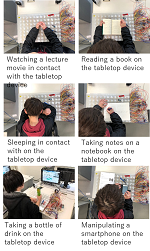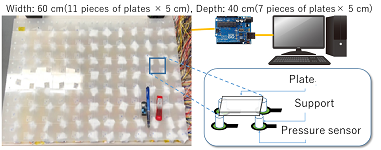圧力センサーを用いた授業中の学習態度を認識するテーブルトップデバイスの開発
概要
ラーニング ・ アナリティックでは大量の学習データの収集が必要であり,そのデータの質が学習者モデルの構築のために重要となる.そのひとつの原因として,教育コンテキストの違った学習データを一緒くたに解析することが,学習者の適切なモデル構築を困難にするとの指摘もある.そこで,本研究では授業中に学習者が机上で振る舞う行為に着目し,受講中の学習者状態が推定可能なテーブルトップインタフェースを開発した.我々はまず机上圧で検出可能な受講者の 6 種類の行為を定義し,そして,机上圧を検出可能なテーブル型デバイスを構築し,機械学習を用いてその机上圧から学習者の状態を認識する手法を開発した.
Abstract
The field of learning analytics has been limited by its frequent dependence on learning logs created by students while learning. Most of the research has dealt with the relationships between learning during a course and the achieved results. Although students’ in-class behavior affects learning achievement, this remains a challenging aspect to study because of the difficulty in collecting relevant data. There is little research wherein in-class behavior is directly analyzed. We have developed a tabletop device that is able to detect the weights and contact areas of objects placed upon it. In this paper, we report a viable classification scheme for student in-class behavior, and demonstrate the potential for machine learning to automatically classify behaviors. The results showed the approach taken by Support Vector Machine (SVM) achieved 66.69% classification accuracy and the student’s in-class behavior detection through the tabletop device might be feasible.


学会発表
- Tessai Hayama, Hidetaka Odate, Naoto Ishida: “Classification of Student’s In-class Behavior Using a Desktop Pressure Sensor”, International Journal on e-Learning, 19(4), 2020.
- Tessai Hayama, Hidetaka Odate, Naoto Ishida , “Classification of Student’s In-class Behavior Using a Desktop Pressure Sensor”, Proceedings of the Joint 10th International Conference on Soft Computing and Intelligent Systems and 19th International Symposium on Advanced Intelligent Systems in conjunction with Intelligent Systems Workshop 2018,p.1-5 (2018)
- 羽山 徹彩, 大舘 英隆, 石田 直登,受講生の状態推定のための圧力センサを用いたテーブルトップインタフェースの開発,情報処理学会 研究報告コンピュータ学習と教育(CLE) 2018-CLE-26(17), pp.1-7, pp.100-103 (2018)
